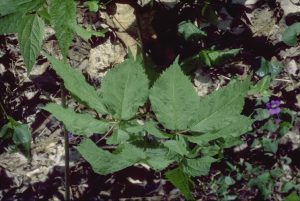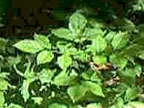
The Ginseng Fungicide Connection
The Problem: When Ginseng is Grown in a Monoculture, it Attracts a Fungus.
How did we come to cultivate ginseng in a monoculture enviroment?
One hears the theory that China cut most of her trees to feed her people 400 years ago, therefore eliminating most organic wild Asian ginseng.
This is what Sarah Harriman says, in her book, The Book of Ginseng: “Because the scant wild population of ginseng comes nowhere meeting the demand for its roots in any one year, ginseng has long been cultivated in China, Korea and Japan”.
In the Orient, Ginseng was grown for centuries on plantations usually under the control of the government and then sold by a government trade monopoly. Soldiers were commonly used as harvesters. Control and security produced the environment for growing ginseng, which needs to faithfully reproduce its natural habitat.
Cultivated ginseng has been grown in Asia for the last 400 years. It has been cultivated in America since the early turn of the century, mostly in Wisconsin.
Sarah Harriman, states, “The plant has never been common, thriving only in small patches in deep woodlands where very specific cultural demands are naturally provided…. The little root…. flourishes only in woods earth, protected from wind, rain and sun by the forest roof of leafy boughs.”
How was ginseng farmed before chemical fungicide spraying in the 1920’s?
Sarah Harriman, describes a late nineteenth century Korean ginseng farm, within walls and armed watch towers as follows: “Each farm is a rectangular compound…Beyond the buildings are parallel rows of low, dark mat sheds with roofs sloping downward toward the south or southwest.”
 The writer of the diary goes on to explain how the plants survived with human help. “Once in each three days interval during it’s whole life the plant is watered, and the bed. carefully inspected to prevent crowding, decay, and the ravages of works and insects”.
The writer of the diary goes on to explain how the plants survived with human help. “Once in each three days interval during it’s whole life the plant is watered, and the bed. carefully inspected to prevent crowding, decay, and the ravages of works and insects”.
The writer then explains that the ginseng beds were changed each year by bringing down new earth from the mountains. “The most successful plantations use woods earth hauled to the farm”.
Each of the early years, the plants are transplanted in the spring, where they are pushed further apart. The diary goes on: “In this second bed the plants remain one year, and are then transplanted to the third bed, and planted still further apart.”
Medicinally, ginseng is said to need seven (7) years to reach maturity, as the book says. “Generally speaking, seven years are required from the time of planting until the plant is medicinally mature”.
So, as Sara comments, it is very labor-intensive operation. “The typical ginseng farm employs and houses a large number of peasant workers to give constant care to the plants”.
Some of these practices came to America when the Fromm brothers successfully transplanted 100 roots from forest to garden in 1904. By 1915 the Fromm brothers were cultivating 15 acres in fields under shade structures, usually lathe. Thus, the American cultivated ginseng farming practices started in Wausau County, Wisconsin, have made it famous as a ginseng Mecca.
As the publication on Wisconsin stated in the fall of 1993: “Today Wisconsin’s 3000 acres of artificially shaded, raised-bed ginseng gardens produce 1.3 to 1.5 million pounds of roots annually….yeilding between $50 million and $70 million each year. And, although Wisconsin leads the pack in ginseng production, biological barriers still complicate the root’s cultivation…. Disease especially fungal diseases can easily wipe out a crop that requires three to four years to reach maturity and an average investment of $30,000 an acre…Ginseng is very susceptible to these diseases and because of that, ginseng growers traditionally have had to use a lot of fungicides”.
The start of the chemical revolution in the 1920’s led to products like Dow Chemicals DDT being used by ginseng farmers both in field and woods grown ginseng. Although, the fungicide has changed the fungal diseases remains about the same.
The pamphlet Ginseng: A Production Guide for North Carolina, comments: “At least a dozen pathogenic diseases (fungus organisms that attack ginseng) have been identified, but only a few have been observed in North Carolina. Alternaria blight is the most serious and widespread fungus disease”.
As W. Scott Persons states in his ‘bible’ American Ginseng Green Gold:
“When a wild plant is domesticated and cultivated in a monoculture (only members of its own kind). Often there is a increase in its susceptibility to disease. Wild ‘sang diggers’ rarely find a diseased plant, and wild simulated gardens suffer less from blights and rots than do plantings under artificial shade. If conditions are suitable, the woods grower may have to deal with one or more of three basic disease types, damping-off, blight and root rot, each of which can be caused by more than one fungus (or) one fungus can cause all three.”
“Damping-off is a fungal disease of young plants that causes them to wilt and fall over within a few days of infection. This usually occurs early in the growing season when the weather is cold and wet. Blight, Alternaria blight is the most common, is spread by spores (small seed-like bodies). These usually travel on the wind, in splashing rain, or on clothing and alight most likely on a leaf surface. The spores remain on the surface until hot, wet weather, then “sprout” and penetrate the leaf cells.”
“Root rot is the least common and infects the leaves of the plant first, where the foliage starts to droop and/or turn reddish, yellow or bronze in spots all over. In addition to Alternaria, at least five other fungal organisms have been associated with root rot, Phytophora being the most common.”
As Scott mentions one of the best ways to protect against disease is to have healthy plants in healthyappropriate soil conditions. A site with excellent drainage and good air circulation is a must. And as the Production Guide states:
 “Avoiding crowding: a very dense plantings are conductive to spread of diseases….give each plant enough space for good air movement and little contact with other plants”.
“Avoiding crowding: a very dense plantings are conductive to spread of diseases….give each plant enough space for good air movement and little contact with other plants”.
So, we can see the current American industry standard for cultivated ginseng is to spray the hell out of the root. Some operations areso fe losing the crop that they spray daily from April to September.
Now the root does not say that it will not absorb the fungicide into its system. In fact, ginseng seems to draw most minerals and trace elements from the ground it is grown in, so that it is impossible for heavily sprayed beds t not have a high level of fungicide residue.
Therefore, the task at hand is to find a natural alternate to heavy chemical toxic fungal sprays. The first clue is the research that Dr. Jeanine Davis has done in the Asheville area. In her document, Advances in Goldenseal Cultivation she states; “Goldenseal shows some promise as a rotational crop for ginseng. It is difficult, in many cases impossible, to grow ginseng in the same location twice. Growers’ experience and preliminary research indicates that goldenseal thrives where ginseng has been grown previously, even where ginseng diseases such as leaf blight and root rot were present”.
 How can that be? Well goldenseal is a natural herbal fungicide. Isn’t that interesting. It is not suprising that Chief Netz of the Lumbee Nation commented that his tribe considers ginseng and goldenseal to be brother and sister. Growing in the same conditions and helping each other as plants. So, goldenseal can clean the soil for the ginseng plants.
How can that be? Well goldenseal is a natural herbal fungicide. Isn’t that interesting. It is not suprising that Chief Netz of the Lumbee Nation commented that his tribe considers ginseng and goldenseal to be brother and sister. Growing in the same conditions and helping each other as plants. So, goldenseal can clean the soil for the ginseng plants.
I also had an experience with Bio-Dynamic farming and learned from Hugh Lovell from Georgia, that one of the preps that Steiner had made in 1928 was a horsetail tea. Horsetail is also a natural, anti-fungal herb and has the highest count of silicone of any plant.
He suggested spraying horsetail in the spring and making a goldenseal tea and spraying that in the fall. This research lead to the 2001 Sierra Grant. See Ginseng Production Utilizing Natural Fungicides.